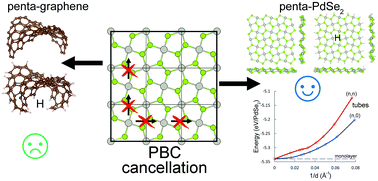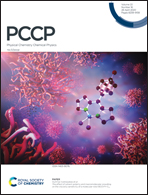Structural stability of single-layer PdSe2 with pentagonal puckered morphology and its nanotubes†
Abstract
Two-dimensional (2D) materials have gained a lot of attention being a new class of materials with unique properties that could influence future technologies. Concomitant computational design and discovery of new two-dimensional materials have therefore become a significant part of modern materials research. The stability of these predicted materials has emerged as the main issue due to drawbacks of the periodic boundary condition approximation that allow one to pass common criteria of stability. Here, based on first-principle calculations, we demonstrate structural stability and instability of several recently proposed 2D materials with pentagonal morphology including the experimentally exfoliated single-layer PdSe2. It is found that an appropriate orientation of the central Pd sublattice with respect to Se2 dimers effectively compensates all mechanical stress and preserves the planar structure of the PdSe2 nanoclusters, while the flakes of all other materials having pentagonal morphology exhibit non-zero curvature induced by excessive interatomic forces. The relative energies of the PdSe2 monolayer and nanotubes per formula unit also confirm that the planar monolayer is a global energy minimum. Like the monolayer, (n,0) PdSe2 tubes are indirect band gap semiconductors with similar band gaps, while (n,n) tubes reveal indirect–direct band gap transitions following the increase of the tube diameter. Small strain energies of large diameter tubes propose their possible experimental realization for various optoelectronic applications.



 Please wait while we load your content...
Please wait while we load your content...